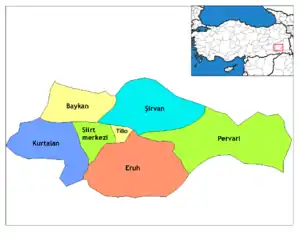Siirt Province
Siirt Province, (Turkish: Siirt ili, Kurdish: Parêzgeha Sêrtê[2]) is a province of Turkey, located in the southeast. The province borders Bitlis to the north, Batman to the west, Mardin to the southwest, Şırnak to the south, and Van to the east. It has an area of 5,406 km² and a total population of 300,695 (as of 2010). The provincial capital is the city of Siirt. The province is considered part of Turkish Kurdistan and has a Kurdish majority.[3][4] The current Governor of the Siirt province is Ali Fuat Atik.[5]
Siirt Province
Siirt ili | |
|---|---|
 Location of Siirt Province in Turkey | |
| Country | Turkey |
| Region | Southeast Anatolia |
| Subregion | Mardin |
| Government | |
| • Governor | Osman Hacıbektaşoğlu |
| Area | |
| • Total | 5,406 km2 (2,087 sq mi) |
| Population (2018)[1] | |
| • Total | 331,670 |
| • Density | 61/km2 (160/sq mi) |
| Area code(s) | 0484 |
| Vehicle registration | 56 |
History
In order to Turkify the Kurds of Siirt,[6] Law 1164 was passed in June 1927,[7] which allowed the creation of Inspectorates-General (Umumi Müffetişlik, UM)[8] that governed with martial law under a state of emergency.[9] The Siirt province was included in the so called First Inspectorate General (Umumi Müfettişlik, UM) in which an Inspector General governed with wide-ranging authority of civilian, juridical and military matters.[8] The UM covered the provinces of Hakkâri, Siirt, Van, Mardin, Bitlis, Sanlıurfa, Elaziğ and Diyarbakır.[8] The Inspectorate Generals were dissolved in 1952 during the government of the Democrat Party.[10] Entrance to Siirt province was forbidden to foreigners until 1965.[9]
In July 1987, the Siirt province was included in to the state of emergency region OHAL, which was declared to counter the Kurdistan Workers' Party (PKK), and governed by a supergovernor who was invested with additional powers than a normal governor, including the power to relocate and resettle whole settlements.[11] In December 1990 with the Decree No. 430, the supergovernor and the provincial governors in the OHAL region received immunity against any legal prosecution in connections with actions they made due to the powers they received from Decree No. 430.[12] In November 1999, the state of emergency under which the province was governed was finally ended.[13]
Districts
Siirt province is divided into 7 districts (capital district in bold):
Notes
- "Population of provinces by years - 2000-2018". Turkish Statistical Institute. Retrieved 9 March 2019.
- "Serokê Parêzgeha Sêrtê yê HDPê Çetîn hat girtin" (in Kurdish). Anadolu Agency. 23 July 2017. Retrieved 27 April 2020.
- Watts, Nicole F. (2010). Activists in Office: Kurdish Politics and Protest in Turkey (Studies in Modernity and National Identity). Seattle: University of Washington Press. p. 167. ISBN 978-0-295-99050-7.
- "Kurds, Kurdistān". Encyclopaedia of Islam (2 ed.). BRILL. 2002. ISBN 9789004161214.
- "T.C Siirt Valiliği". www.siirt.gov.tr. Retrieved 2020-03-25.
- Üngör, Umut. "Young Turk social engineering : mass violence and the nation state in eastern Turkey, 1913- 1950" (PDF). University of Amsterdam. pp. 244–247. Retrieved 8 April 2020.
- Aydogan, Erdal. "Üçüncü Umumi Müfettişliği'nin Kurulması ve III. Umumî Müfettiş Tahsin Uzer'in Bazı Önemli Faaliyetleri". Retrieved 8 April 2020.
- Bayir, Derya (2016-04-22). Minorities and Nationalism in Turkish Law. Routledge. p. 139. ISBN 978-1-317-09579-8.
- Jongerden, Joost (2007-01-01). The Settlement Issue in Turkey and the Kurds: An Analysis of Spatical Policies, Modernity and War. BRILL. pp. 53. ISBN 978-90-04-15557-2.
- Bozarslan, Hamit (2008-04-17). Fleet, Kate; Faroqhi, Suraiya; Kasaba, Reşat; Kunt, I. Metin (eds.). The Cambridge History of Turkey. Cambridge University Press. p. 343. ISBN 978-0-521-62096-3.
- Jongerden, Joost (2007). The Settlement Issue in Turkey and the Kurds. Brill. pp. 141-142. ISBN 978-90-47-42011-8.
- Norwegian Refugee Council/Global IDP Project (4 October 2002). "Profile of internal displacement: Turkey" (PDF). p. 78.
- "Profile of internal displacement: Turkey" (PDF). ecoi. p. 14. Retrieved 8 April 2020.

